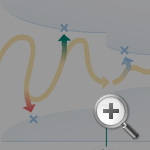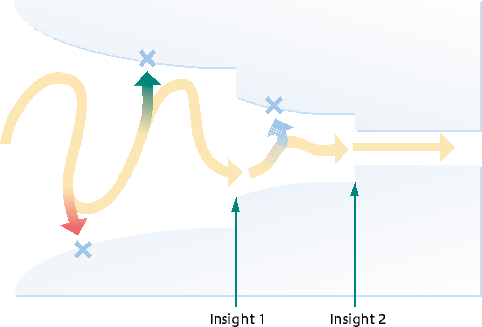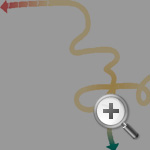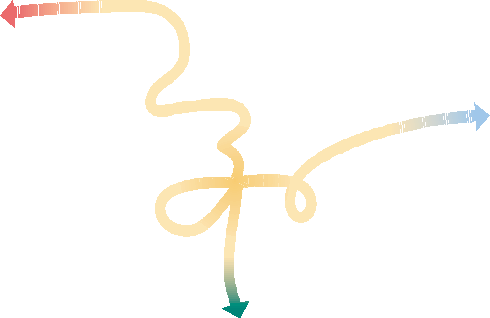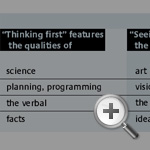Decision Making: It’s Not What You Think
How should decisions be made? Easy, we figured that out long ago. First define the problem, then diagnose its causes, next design possible solutions, and finally decide which is best. And, of course, implement the choice.
But do people always make decisions that way? We propose that this rational, or “thinking first,” model of decision making should be supplemented with two very different models — a “seeing first” and a “doing first” model. When practicing managers use all three models, they can improve the quality of their decisions. Healthy organizations, like healthy people, have the capacity for all three.
Consider how a real decision was made, a personal one in this case. It begins with a call from an aunt.
“Hi, kiddo. I want to buy you a housewarming present. What’s the color scheme in your new apartment?”
“Color scheme? Betty, you’ve got to be kidding. I’ll have to ask Lisa. Lisa, Betty wants to know the color scheme of the apartment.”
“Black,” daughter Lisa says.
“Black? Lisa, I’ve got to live there.”
“Black,” she repeats.
A few days later, father and daughter find themselves in a furniture store. They try every desk, every chair: Nothing works. Shopper’s lethargy sets in. Then Lisa spots a black stool: “Wouldn’t that look great against the white counter?” And they’re off. Within an hour, they have picked out everything — in black, white and steel gray.
The extraordinary thing about this ordinary story is that our conventional theories of decision making can’t explain it. It is not even clear what the final decision was: to buy the stool; to get on with furnishing an apartment; to do so in black and white; to create a new lifestyle? Decision making can be mysterious.
The Limits of “Thinking First”
Rational decision making has a clearly identified process: define → diagnose → design → decide. However, the rational approach turns out to be uncommon.
Years ago, one of us studied a host of decisions, delineating the steps and then laying them out. A decision process for building a new plant was typical. The process kept cycling back, interrupted by new events, diverted by opportunities and so on, going round and round until finally a solution emerged. The final action was as clear as a wave breaking on the shore, but explaining how it came to be is as hard as tracing the origin of that wave back into the ocean.
Often decisions do not so much emerge as erupt. Here is how Alexander Kotov, the chess master, has described a sudden insight that followed lengthy analysis:
“So, I mustn’t move the knight. Try the rook move again. …
At this point you glance at the clock. ‘My goodness! Already 30 minutes gone on thinking about whether to move the rook or the knight. If it goes on like this you’ll really be in time trouble.’ And then suddenly you are struck by the happy idea —why move rook or knight? What about B-QN1? And without any more ado, without analysis at all, you move the bishop. Just like that.”
Perhaps, then, decision making means periods of groping followed by sudden sharp insights that lead to crystallization, as A. Langley and co-authors suggested in a 1995 Organizational Science article. (See “Insight: Groping Precedes Zeroing In.”)
Or perhaps it is a form of “organized anarchy,” as Stanford professor James March and colleagues have written. They characterize decision making as “collections of choices looking for problems, issues and feelings looking for decision situations in which they may be aired, solutions looking for issues to which they might be an answer, and decision makers looking for work.” (See “Choices Looking for Problems.”)
But is the confusion, as described by those authors, in the process, or is it in the observers? Maybe messy, real-life decision making makes more sense than we think, precisely because so much of it is beyond conscious thought.
“Seeing First”
Insight — “seeing into” — suggests that decisions, or at least actions, may be driven as much by what is seen as by what is thought. As Mozart said, the best part about creating a symphony was being able to “see the whole of it at a single glance in my mind.” So, understanding can be visual as well as conceptual.
In W. Koehler’s well-known 1920s experiment, an ape struggled to reach a banana placed high in its cage. Then it saw the box in the corner — not just noticed it, but realized what could be done with it — and its problem was solved. Likewise after Alexander Fleming really saw the mold that had killed the bacteria in some of his research samples (in other words, when he realized how that mold could be used), he and his colleague were able to give us penicillin. The same can be true for strategic vision. Vision requires the courage to see what others do not — and that means having both the confidence and the experience to recognize the sudden insight for what it is.
A theory in Gestalt psychology developed by G. Wallas in the 1920s identifies four steps in creative discovery: preparation → incubation → illumination → verification.
Preparation must come first. As Louis Pasteur put it, “Chance favors only the prepared mind.” Deep knowledge, usually developed over years, is followed by incubation, during which the unconscious mind mulls over the issue. Then with luck (as with Archimedes in the bathtub), there is that flash of illumination. That eureka moment often comes after sleep — because in sleep, rational thinking is turned off, and the unconscious has greater freedom. The conscious mind returns later to make the logical argument. But that verification (reasoning it all out in linear order for purposes of elaboration and proof ) takes time. There is a story of a mathematician who solved a formula in his sleep. Holding it in his mind’s eye, he was in no rush to write it down. When he did, it took him four months!
Great insights may be rare, but what industry cannot trace its origins to one or more of them? Moreover, little insights occur to all of us all the time. No one should accept any theory of decision making that ignores insight.
“Doing First”
But what happens when you don’t see it and can’t think it up? Just do it. That is how pragmatic people function when stymied: They get on with it, believing that if they do “something,” the necessary thinking could follow. It’s experimentation — trying something so that you can learn.
A theory for “doing first,” popularized in academia by organizational-behavior professor Karl Weick, goes like this: enactment → selection → retention.
That means doing various things, finding out which among them works, making sense of that and repeating the successful behaviors while discarding the rest. Successful people know that when they are stuck, they must experiment. Thinking may drive doing, but doing just as surely drives thinking. We don’t just think in order to act, we act in order to think.
Show us almost any company that has diversified successfully, and we will show you a company that has learned by doing, one whose diversification strategy emerged through experience. Such a company at the outset may have laid out a tidy strategy on the basis of assessing its weaknesses and strengths (or, if after 1990, its “core competencies”), which it almost certainly got wrong. How can you tell a strength from a weakness when you are entering a new sphere? You have no choice but to try things out. Then you can identify the competencies that are really core. Action is important; if you insist on “thinking first” and, for example, doing formalized strategic planning (which is really part of the same thing), you may in fact discourage learning.
Making Decisions Through Discussion, Collage and Improvisation
Thus the three major approaches to decision making are “thinking first,” “seeing first” and “doing first.” They correlate with conventional views of science, art and craft. The first is mainly verbal (comprising words in linear order), the second is visual, the third is visceral. Those who favor thinking are people who cherish facts, those who favor seeing cherish ideas and those who favor doing cherish experiences. (See “Characteristics of the Three Approaches to Making Decisions.”)
We have for some years conducted workshops on the three approaches with midcareer managers sent by Asian, European and North American companies to our International Masters Program in Practicing Management (www.impm.org). We begin with a general discussion about the relationship between analysis, ideas and action. It soon becomes evident that practicing managers recognize the iterative and connected nature of those elements. We then ask small groups first to discuss an issue for about an hour (one of their own or else what we call a “provocative question.” For example: “How do you manage customer service when you never see a customer?” or “How do you organize without structure?”), summarize their conclusions on a flip chart and report back to the full group. Next we give the groups colored paper, pens, scissors and glue. Each small group must create a collage about the issue they discussed in the thinking-first session. At the end of that second workshop, the groups view one another’s images and compare “seeing first” with “thinking first” — in terms of both process and results. Finally, each group, with only a few minutes of preparation time permitted, improvises a skit to act out its issue. Again, the groups consider the results.
Reactions to the approaches are revealing. Participants note that in the thinking-first workshop, the initial discussions start off easily enough, no matter what the mix of nationalities or work backgrounds. Participants list comments on flip charts and spontaneously use bulleted items and numbers — with the occasional graph thrown in. Almost no time is spent in discussing how to go about analyzing the problem. Groups quickly converge on one of several conventional analytic frameworks: cause and effect, problem and solution, pros and cons, and so on.
Many participants observe that such frameworks, particularly when adopted early, blunt exploration. Quality and depth of analysis may be sacrificed for process efficiency. Thinking-first workshops encourage linear, rational and rather categorical arguments. All too often, the result is a wish list, with disagreements hidden in the different points. In other words, there may be less discipline in thinking first than we believe. Thinking comes too easily to most of us.
But when a group must make a picture, members have to reach consensus. That requires deeper integration of the ideas. “We had to think more to do this,” a participant reported. The artistic exercise “really forces you to capture the essence of an issue,” another added. People ask more questions in the seeing-first exercise; they become more playful and creative.
“In ‘thinking first,’ we focused on the problems; in ‘seeing first,’ we focused on the solutions,” one person said. One group believed it had agreement on the issue after the thinking-first workshop. Only when the picture making began did its members realize how superficial that agreement was —more of a compromise. In contrast, when you really do see, as someone said, “The message jumps out at you.” But to achieve that, the group members have to find out more about one another’s capabilities and collaborate more closely. “I felt it became a group project, not just my project,” said a participant who had chosen the topic for his group. The seeing-first exercise also draws out more emotions; there is more laughter and a higher energy level. This suggests that being able to see a trajectory — having a vision about what you are doing — energizes people and so stimulates action. In comparing the seeing-first exercise with the thinking-first discussion, a participant remarked, “We felt more liberated.” The pictures may be more ambiguous than the words, but they are also more involving. A frequent comment: “They invite interpretation.”
One particularly interesting observation about the pictures was that “the impression lasts longer.” Studies indicate that we remember pictures much longer and more accurately than words. As R. Haber demonstrated in Scientific American in 1970, recall of images, even as many as 10,000 shown at one-second intervals, is nearly 98% — a capability that may be linked to evolution. Humans survived by learning to register danger and safety signals fast. Emotion, memory, recall and stimulation are powerfully bundled in “seeing first.” Contrast that with one comment after the thinking-first workshop: “Twenty-four hours later, we won’t remember what this meant.”
In fact, although many participants have not made a picture since grade school, the art produced in the seeing-first workshops is often remarkable. Creativity flows freely among the managers, suggesting that they could come up with more creative ideas in their home organizations if they more often used symbols beyond words or numbers.
Our multicultural groups may like the art workshop for overcoming language barriers, but groups of managers from the same company, country or language group have responded equally well. One British participant who was working on a joint venture with an American partner found that out. He met with his U.S. counterpart a few days after the workshops. “We talked past each other for two hours,” he reported. When he suggested they create a picture of their common concerns, they finally were able to connect.
The improvisation skits — “doing first” — generate more spontaneity. Participants respond to one another intuitively and viscerally, letting out concerns held back in conversation and even in artwork. For example, turf battles become evident in the way people stand and talk. Humor, power, fear and anger surface. (M. Crossen and M. Sorrenti discuss improvisation at length in a helpful article published in 1997 in Advances in Strategic Management.)
Weick has suggested that a key aspect of effective action in organizations is the ability to remain open to signals from others, even under extreme pressure. He believes that such heedful-ness, as he calls it, is a finely honed skill among group improvisers such as jazz musicians. Organizations that recognize opportunities for improvisation — and hone the skills required — increase their capacity for learning. In improvisation, people have to respond with a speed that eliminates many inhibitions. “Having to just act gets rid of the fears,” a participant said. Another added, after watching a colleague play the role of a frustrated bank customer, “The output can be scarily real.”
Mere words, in contrast, feel more abstract and disconnected — numbers, even more so — just as the aggregations of marketing are more abstract than the experience of selling. The skits bring out what the words and numbers do not say —indeed, what problems they cause. “Not everything is unsayable in words,” claimed playwright Eugène Ionesco, “only the living truth.” Or as Isadora Duncan, the modern-dance pioneer, insisted, “If I could say it, I wouldn’t have to dance it.” Thus “doing first” facilitates the dancing that is so lacking in many of today’s organizations.
Enough Thinking?
The implications for our large, formalized, thinking-obsessed organizations are clear enough: not to suspend thinking so much as put it in its place, alongside seeing and doing. Isn’t it time we got past our obsession with planning and programming, and opened the doors more widely to venturing and visioning? A glance at corporate reports, e-mail and meetings reveals that art is usually something reserved for report covers — or company walls. And when organizations separate the thinking from the doing, with the former coming from the heads of powerful formulators and the latter assigned to the hands of ostensibly docile implementers, those formulators lose the benefits of experimenting — and learning.
Each approach has its own strengths and weaknesses. (See “When Each Decision-Making Approach Works Best.”) “Thinking first” works best when the issue is clear, the data reliable and the world structured; when thoughts can be pinned down and discipline applied, as in an established production process. “Seeing first” is necessary when many elements have to be combined into creative solutions and when commitment to those solutions is key, as in much new-product development. The organization has to break away from the conventional, encourage communication across boundaries, bust up cerebral logjams and engage the heart as well as the head. “Doing first” is preferred when the situation is novel and confusing, and things need to be worked out. That is often the case in a new industry — or in an old industry thrown into turmoil by a new technology. Under such circumstances, complicated specifications get in the way, and a few simple relationship rules can help people move forward in a coordinated yet spontaneous manner.
That suggests the advantages of combining all three approaches. In order to learn, a company group might tackle a new issue first by craft, which is tied to doing; then, in order to imagine, by art, which is tied to seeing; finally, in order to program, by science, which is tied to thinking. In ongoing situations, art provides the overview, or vision; science specifies the structure, or plan; and craft produces the action, or energy. In other words, science keeps you straight, art keeps you interested, and craft keeps you going. No organization can do without any one approach. Isn’t it time, then, to move beyond our narrow thinking about decision making: to get in touch, to see another point of view?

